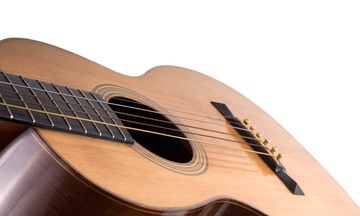
- Old Stuff
- Instruments
- 1882 Balmer-Weber
1882 Balmer-Weber
1882 Balmer-Weber
This has got to be, without question, the most perfect, most understatedly beautiful, non-Martin-made copy of a Martin guitar I’ve ever seen, ever. Its interior printed label reads BALMER and WEBER’S MUSIC HOUSE / 311 N. 5th St., / St. Louis, Mo. and below that, hand-written in ink in a beautiful cursive script right on the label is Dec. 22nd, 1882 The style, the cleanliness of line and curve, the marquetry, and the impeccable workmanship all speak quite loudly of this guitar’s having been made by a German immigrant well-versed in all of Martin's designs and building techniques, and I had to look long and hard to convince myself that it was not made by Martin themselves. Even the marquetry is identical to Martin’s, almost surely came from the same source in Germany that Martin used, and the adherence to Martin’s overall techniques is so close that I could almost swear that this guitar must have been made by a former Martin employee. There is, however, not a single indication anywhere in or on the guitar as to who made it. St. Louis was a destination and a stopping point in the 19th century, with The Gateway Arch, completed in 1965, being a monument to the westward expansion of the American dream. St. Louis’ history of German instrument makers is a long one, with a surprising number of 19th-century zithers made there still showing up today, though very few guitars. This particular one approximates the Martin Size 2, a bit smaller than their Standard Size 1 of the day with 24.5” scale, and quite popular for parlor playing, back when there were still real parlors. The back and sides are of perfectly straight-grained, prime Brazilian rosewood, the top spruce, the fingerboard and bridge ebony, and the nut and saddle, all original, are of course ivory. And the tuning machines: they’re original too, and are just something else. Each gear has an extension knob, so that when putting on new strings one can pull the gears part way out to disengage them for twirling, in order to get the job done more quickly; this is American ingenuity at it’s 19th-century finest. The buttons are, not unsurprisingly, real ivory. The case is also of wood, of course, with all original latches, hinges and handle, and partially lined with period patterned wallpaper, partly with green felt. Overall condition of the guitar is most excellent with no major indignities ever having been perpetrated on it; there is evidence of a few minor, ancient back cracks that had slight attempts made on them many decades ago, nearly invisible, and the back seam could use a little attention. Five of the ivory bridge pins with ebony dots are original; one ivory pin with abalone dot is a very old replacement. The action is a bit high but quite playable; I would recommend not fooling with it. Guitars of this caliber do not come along very often these days; in this wonderful condition, almost never. Offered here as is for $4995 w/ohsc































